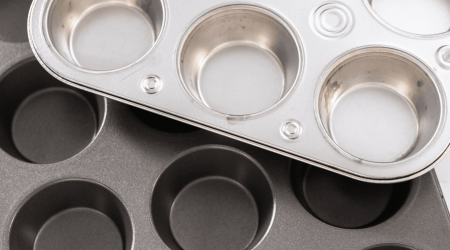Over the years, I have accumulated quite a collection of cake, cupcake, and loaf tins in an array of shapes, sizes, and colours. So, it's worth mentioning that the colour/hue of your tins can have a predominant effect on your overall bake.
Understanding how these tins interact with the batter during the baking process is essential for achieving the desired results, as the colour of your tin can significantly impact your final bake.

If you think about it, it's much the same as you on a sunny day! By that, I mean if you wear a light T-shirt, you'll feel pretty cool and at one with the weather. However, if you wear a dark-coloured T-shirt, it usually absorbs the heat from the sun and distributes it around your body, making you feel toasty when you don't really need to. The same is said about your tins/bakes.
This analogy illustrates that tin colour matters. Darker tins, like a dark t-shirt, hasten the baking process by absorbing and distributing heat, resulting in a faster and often darker/browned bake. Whereas in contrast, lighter and anodized tins reflect heat, promoting a more gradual and even baking process.
So depending on what you wish to bake will depend on the tin you use.
To simplify:
Understanding how these tins interact with the batter during the baking process is essential for achieving the desired results, as the colour of your tin can significantly impact your final bake.

If you think about it, it's much the same as you on a sunny day! By that, I mean if you wear a light T-shirt, you'll feel pretty cool and at one with the weather. However, if you wear a dark-coloured T-shirt, it usually absorbs the heat from the sun and distributes it around your body, making you feel toasty when you don't really need to. The same is said about your tins/bakes.
This analogy illustrates that tin colour matters. Darker tins, like a dark t-shirt, hasten the baking process by absorbing and distributing heat, resulting in a faster and often darker/browned bake. Whereas in contrast, lighter and anodized tins reflect heat, promoting a more gradual and even baking process.
So depending on what you wish to bake will depend on the tin you use.
To simplify:
- Black tins absorb more heat, speeding up the browning/baking process.
- Lighter tins reflect heat, leading to slower baking times.
Last edited:

